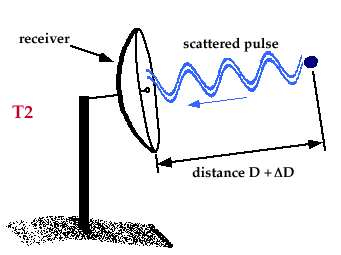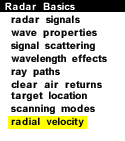
|
Doppler radars can measure the velocity of targets
relative to the radar.
| For example, at time T1 a pulse is sent towards a target and it returns a target distance "D". |

|
|
2) At time T2, another pulse is sent towards the same
target and returns a target distance
"D + |

|
The distance to target has changed from times T1 to T2, resulting in a
phase shift between the two return signals, which
Doppler radars are capable of measuring.
By knowing the phase shift,
the wavelength and the time interval from T1 to T2,
the distance
![]() D that
the target
has moved relative to the radar can be computed.
These pieces of information are then used to compute
the target velocity relative to the radar.
If the target is
moving sideways so that its distance relative to the radar does not change,
the radar will record zero velocity for that target.
D that
the target
has moved relative to the radar can be computed.
These pieces of information are then used to compute
the target velocity relative to the radar.
If the target is
moving sideways so that its distance relative to the radar does not change,
the radar will record zero velocity for that target.
|




